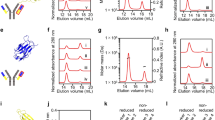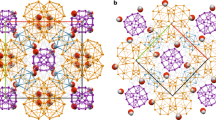Abstract
DETAILED investigations of the association behaviour of the genetic variants of β-lactoglobulin have shown that the A variant aggregates strongly and reversibly to a tetramer1,2 of 144,000 molecular weight in the cold between pH. 3.7 and 5.2. The thermodynamics of this association have established the tetramer structure to be cyclic, involving the closing of four bonds1,2, and its hydrodynamic properties2,3 show it to be compact. A small-angle X-ray scattering examination of this association4 has led to the conclusion that, of the various general types of possible tetramer structures, a cubic array of eight spheres was the most probable. This conclusion was based on comparison of the measured radius of gyration of the tetramer (34.4 Å) with values calculated for various models formed of four of the monomeric units deduced by Green and Aschaffenburg5 from X-ray diffraction examination. These monomeric units have been shown to persist in solution4. The monomer unit consists of a combination of two identical spheres (of molecular weight 18,000) 17.9 Å in radius, impinging by 2.3 Å along their centre-to-centre axis; these two spheres are, furthermore, related by a dyad axis of symmetry through the plane of contact formed between them. Recently, we have carried out a detailed examination of compact models in the light of known structural requirements, the results of which we wish to report in this communication. The basic requirements are that all four monomer molecules must be identical with each other2, the monomer structure must be maintained intact in the tetramer4, and the structure must fit all known experimental information and be symmetrical in nature6.
This is a preview of subscription content, access via your institution
Access options
Subscribe to this journal
Receive 51 print issues and online access
$199.00 per year
only $3.90 per issue
Buy this article
- Purchase on Springer Link
- Instant access to full article PDF
Prices may be subject to local taxes which are calculated during checkout
Similar content being viewed by others
References
Townend, R., and Timasheff, S. N., J. Amer. Chem. Soc., 82, 3168 (1960).
Timasheff, S. N., and Townend, R., J. Amer. Chem. Soc., 83, 464 (1961).
Townend, R., Winterbottom, R. J., and Timasheff, S. N. J. Amer. Chem. Soc., 82, 3161 (1960).
Witz, J., Timasheff, S. N., and Luzzati, V., J. Amer. Chem. Soc., 86, 168 (1964).
Green, D. W., and Aschaffenburg, R., J. Mol. Biol., 1, 54 (1959).
Herskovits, T. T., Townend, R., and Timasheff, S. N., J. Amer. Chem. Soc. (in the press).
The cubic structure (Fig. 1B) could be satisfied also if each monomer sub-unit formed bonds with two sub-units of other monomers on tetramerization. This would require the closing of eight bonds on tetramerization and is thus rather unlikely. In this case, the symmetry requirements would be satisfied only if the eight bonds were of a heterologous, rather than homologous, nature.
Tanford, C., J. Amer. Chem. Soc., 84, 4240 (1962).
Kauzmann, W., Adv. in Protein Chem., 14, 1 (1959).
Némethy, G., Steinberg, I. Z., and Scheraga, H. A., Biopolymers, 1, 43 (1963).
Timasheff, S. N., in Proteins and Their Interactions (Avi Publishing Co., Westport, Conn., in the press).
Author information
Authors and Affiliations
Rights and permissions
About this article
Cite this article
TIMASHEFF, S., TOWNEND, R. Structure of the β-Lactoglobulin Tetramer. Nature 203, 517–519 (1964). https://doi.org/10.1038/203517a0
Issue Date:
DOI: https://doi.org/10.1038/203517a0
This article is cited by
-
Conformation changes ofβ-lactoglobulin: An ATR infrared spectroscopic study of the effect ofpH and ethanol
Journal of Protein Chemistry (1994)
-
Probing the fatty acid binding site of β-lactoglobulins
Journal of Protein Chemistry (1993)
-
Binding of benzo(α)pyrene, ellipticine, and cis-parinaric acid to β-lactoglobulin: Influence of protein modifications
Journal of Protein Chemistry (1992)
-
Proteins as potential bacterial growth inhibitors in foods: Suppression of the activity of water by proteins as determined by NMR relaxation methods
Journal of Industrial Microbiology (1988)
-
Investigation of differences in the tertiary structures of food proteins by small-angle X-ray scattering
Journal of Industrial Microbiology (1988)
Comments
By submitting a comment you agree to abide by our Terms and Community Guidelines. If you find something abusive or that does not comply with our terms or guidelines please flag it as inappropriate.



